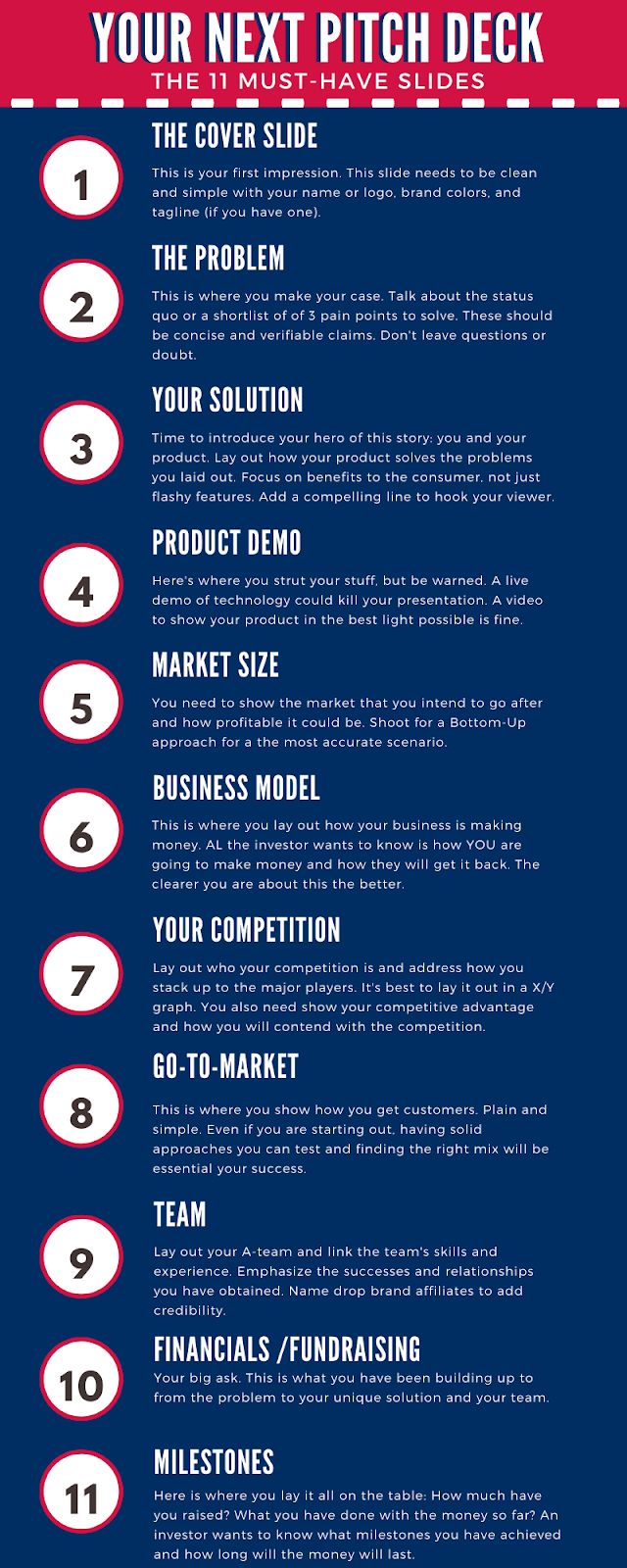
If you’re raising money for your business, having an impressive pitch deck is key in your fundraising toolkit. A great pitch deck gets potential investors excited about your idea and engages them in a conversation about your business, hopefully leading to an investment.
The purpose of a pitch deck is not to raise money, but to get to the next meeting. Your pitch deck and presentation are among the first things that an investor will see to learn about your company. Your goal is to spark interest, not just show yourself out the door.
Here’s what you should include in your pitch deck:
1. Vision and value proposition: A quick one-sentence overview of your business and the value you provide to customers.
2. The problem: Discuss the problem you are solving and who has the problem. Tell a relatable story to make the problem real.
3. Target market and opportunity: Expand on who your ideal customer is, the market size, and how you position your company.
4. The solution: Describe your product or service and how it addresses the problems you outlined earlier.
5. Revenue model or business model: Talk about how your product makes money and its pricing in relation to the market.
6. Traction and validation/roadmap: Highlight any sales or early adopters and your milestones.
7. Marketing and sales strategy: Outline your marketing and sales plan and highlight any unique approaches you have.
8. Team: Explain why you and your team are the right people to build and grow the company.
9. Financials: Provide sales forecasts, income statements, and cash flow forecasts for at least three years in a clear and concise format.
10. Competition: Describe how you fit into the competitive landscape and what advantages you have over others.
11. Investment and use of funds: Ask for the money, explain why you need it, and how you plan to use it. Mention any existing investors.
Additional slides that are often found in investor presentations:
– Exit strategy: Outline potential acquirers or IPO options.
– Partnerships: Highlight key strategic partnerships critical to success.
– Demo and screenshots: Show potential investors how your product works.
– Other documentation: Prepare additional detailed information to provide upon request.
Tips to make your pitch successful:
– Keep it simple: Focus on high-level ideas and leave room for questions.
– Skip the bullets: Use large fonts, limit text, and use images to convey your message.
– Tell a story: Grab interest and build excitement by telling relatable stories.
– Keep it short: Allow time for questions and discussion.
– Be realistic with market opportunity: Focus on attainable goals and bottom-up forecasts.
– Ask for the money: Explain the amount and purpose, and discuss your financial forecasts.
– Keep your deck current: Update with the latest progress and roadmap.
– Send your deck as a PDF: Ensure the intended formatting is preserved.
– Deck should stand alone: Provide enough content for independent review.
Documents to have prepared after pitching:
– Executive summary: A two-to-three-page overview of your business.
– Technical documentation: Detailed explanations of your technology, if applicable.
– Detailed financial models: Provide three-year forecasts and visually represent data.
– Detailed market research: Be prepared to provide additional information if requested.
Hello!
I’m Andrew Brooks, a seasoned finance consultant from the USA and the mind behind phonenumber247.com.
My career is built on a foundation of helping individuals and businesses thrive financially in an ever-changing economic landscape. At phonenumber247.com, my aim is to demystify the complex world of finance, providing clear, actionable advice that can help you navigate your financial journey with confidence. Whether it’s personal finance management, investment strategies, or understanding the nuances of market dynamics, I’m here to share insights and tools that can propel you towards your financial goals.
Welcome to my digital space, where every piece of advice is a step closer to financial clarity and success!
